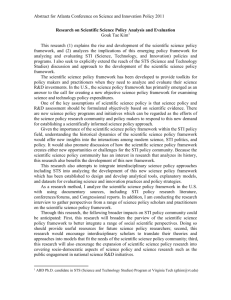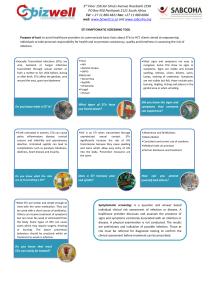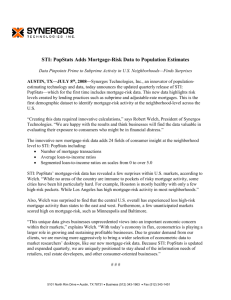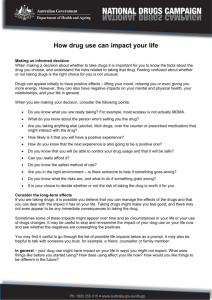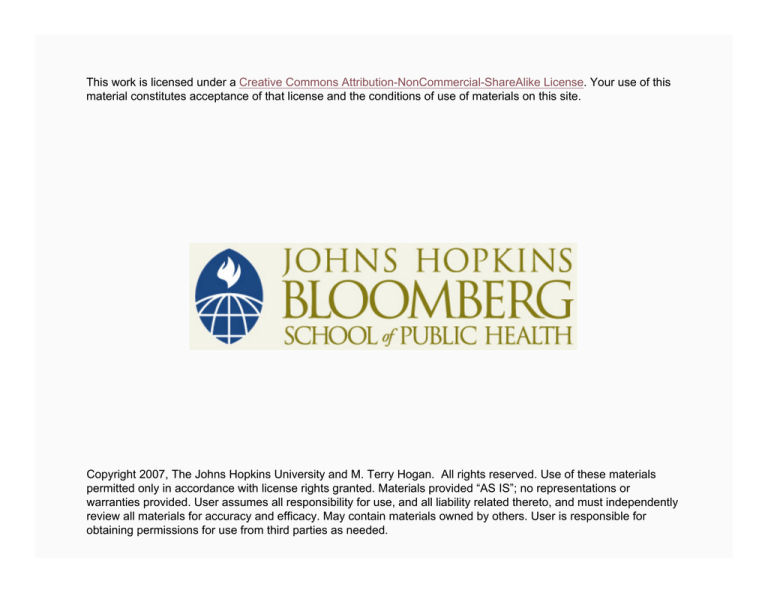
This work is licensed under a Creative Commons Attribution-NonCommercial-ShareAlike License. Your use of this
material constitutes acceptance of that license and the conditions of use of materials on this site.
Copyright 2007, The Johns Hopkins University and M. Terry Hogan. All rights reserved. Use of these materials
permitted only in accordance with license rights granted. Materials provided “AS IS”; no representations or
warranties provided. User assumes all responsibility for use, and all liability related thereto, and must independently
review all materials for accuracy and efficacy. May contain materials owned by others. User is responsible for
obtaining permissions for use from third parties as needed.
STI Prevention: Housekeeping and How We Use
Public Health
M. Terry Hogan, MPH
Johns Hopkins University
Why this Course?
To make public health practitioners aware of the scope of the STI
problem worldwide
To demonstrate the application of biology, epidemiology, and
behavioral aspects of STIs in the development of policy and program
3
What Will You Learn to Do?
Describe the etiology of common STIs
Identify clinical presentations and sequelae of STIs
Describe the epidemiology of selected STIs
Explain theoretical and practical issues related to the design and
implementation of STI intervention control policies and programs
Describe social, policy, and political barriers to STI program
implementation
Develop a memo and a presentation illustrating the importance of
STI epidemiology in policy and program development
4
The Lingo
STI = STD = sexually transmitted infection or disease
GC = gonorrhea
CT = chlamydia
HPV = human papillomavirus
HSV-1 or HSV-2 = herpes type 1 or 2
BV = bacterial vaginosis
Trich = trichomoniasis
PID = pelvic inflammatory disease
5
Lectures
Part 1
− Introduce concepts of STI surveillance and control and
epidemiologic information essential to policy and program
development
Part 2
− In-depth information on specific STIs and policy and program
issues unique to these STIs
Part 3
− Highlight ongoing STI policy and programming efforts from
leading experts
6
What Are the Requirements for the Memo?
Briefing memo on STI control policy or program of your choice
− Annotated bibliography—annotated and presented as an
attachment
− Attachments—no more than three attachments (one is the
bibliography) and additional attachments must include only
supporting graphs or charts
No more than one-and-a-half pages
Much more information to come during lecture four
7
What Are the Requirements for the Presentation?
Create a PowerPoint presentation (no more than five slides)
Record a three minute audio presentation to accompany the slides
Much more information to come during lecture four
8
Public Health and STI Policy and Programming: What Is
Public Health?
Public health authority stems from the “police powers” in the
Constitution
Public health has the force of law
Public health is political
Public health is primarily funded by tax dollars
Public health requires balancing the health needs of the population
with individual choice
9
What Makes Public Health Different from Clinical Care?
“The focus of public health is the community. The
‘patient’ is a whole population unit. The shift in
professional orientation which occurs as the unit of
attention moves from the individual to the group must
be clearly recognized and explicitly stated because it
has led to many misunderstandings in the past.”
—C.E. Taylor
Source: Taylor, C.E. Ethics for an International Health Profession. Science (1966); 153: 716-720
10
What Are the Core Functions of Public Health?
Assessment
− Collect, analyze, and publish health status information in a
systematic manner
Policy development
− Develop comprehensive policy and program based on
scientifically sound information
Assurance
− Guarantee necessary communitywide health services
Communication*
Source: Committee for the Study of the Future of Public Health. The Future of Public Health (1988). Division of
Health Care Services Institute of Medicine. National Academy Press, Washington, DC. *Bloomberg School of
Public Health (addition 2000).
11
Public Health Model
Source: USPHS, Essential Public Health Services Work Group (1994)
12
What Has Changed in the Perception of the Role of
Public Health?
Increased awareness of infectious diseases and public health
infrastructure
Dichotomy between public attitudes and public policy
STD and TB clinics provided front-line clinical services in 9/11 and
bio-terror attacks
HIV and STD prevention emphasis was reduced in the post-9/11
environment and emerging infections that threaten national security
have become more prominent
13
STI Prevention POLICY Strategies: What Are Current
STI Prevention Policy Strategies?
1. Ideologically driven strategies
2. Gray-science strategies
3. Sound-science strategies
14
1. Ideologically Driven Strategies
Definition
− Strategy not based on available scientific evidence or a
distortion on available scientific evidence
Example
− Abstinence-only policies
X Promotion of abstaining from sexual behavior
X Rooted in religious beliefs/moral ideals
15
2. Gray-Science Strategies
Definition
− Strategy where available scientific evidence is contradictory or
where liabilities may outweigh benefits
Examples
− Policies for population-based treatment for STIs to prevent HIV
transmission
X Rakai, Uganda findings
X Mwanza, Tanzania findings
− Partner-administered therapy policies
X Balance of benefits and liabilities
16
3. Sound-Science Strategies
Definition
− Strategies where available
− Scientific evidence mostly supports benefits and effectiveness
Examples
− Targeting core transmitters
X Commercial sex workers
X Injection drug users
X MSM
− Condom use promotion policies (100% condom in Thailand)
− Vaccination for HPV, Hep B
17
Section B
STI Prevention PROGRAMMING Strategies
What Are Current STI Prevention Program Strategies?
1.
2.
3.
4.
5.
6.
7.
Surveillance
Outreach and field investigation
Community education
Community partnership
Prevention advocacy
Policy compliance
STI program development
− Clinic and laboratory services
− Case management and partner services
− Behavioral interventions
8. Professional education
9. Program evaluation
10.Research partnerships
19
1. Surveillance Strategies
Surveillance
− Sentinel—screen the populations at high risk of infection due to
behavior or biology
− Morbidity reports—require sentinel reproductive health events
be reported to a centralized health authority
− Surveys—conduct behavioral and screening surveys in the
community(ies) at high risk
− Case management—maintain case files of STIs for surveillance,
research, and program monitoring
20
2. Outreach and Field Investigation Strategies
Outreach investigation
− Reports—collect demographic data to describe trends in the
community
− Field staff—identify and train workers to contact community
members to educate, notify, and counsel
− Screen—establish screening programs
− Case investigation—develop protocols for case investigation,
management, and follow-up
21
3. Community Education Strategies
Information dissemination
− Educate—send field staff to community venues to offer
educational and informational sessions
− Centralize—develop a central authority to house and analyze
data
− Market—develop marketing campaigns, e.g., social marketing
for disease recognition
22
4. Community Partnership(s)
Partnership development
− Liaison—identify community leaders to act as liaison with
program
− Collaborate—establish advisory panels for policy and program
development
− Partner—work with advisory panels when producing marketing
outreach
− Disseminate—share information about morbidity, prevention
programs, and results
23
5. Encourage Prevention Advocacy
Policy activities
− Coordinate—work with advisory panel(s) to bring attention to
STIs in the community
− Mobilize—assist advisory panel(s) to bring community concerns
to policy makers
− Educate—develop information packages for policy makers and
program directors
− Advise—maintain advisory role to community, policy makers,
and program directors
24
6. Assure Policy Compliance
Regulatory and law enforcement
− Database—monitor required reporting of diseases by providers
and laboratories
− Disseminate—send information regarding laws and regulations to
providers and laboratories at least annually
− Advise—participate in the development and implementation of
laws and regulations
25
7. Development Strategies
Program development
− Assessment—use morbidity reports, community screening
information, etc., to inform policy and program priorities
− Target—identify populations at great risk for infection
− Medical management—assure compliance with established
standards of care
− Case management—apply proven and new techniques to STI
case management
26
8. Supporting Professional Education
Skilled workforce maintenance
− Assessment—conduct staff needs assessments, chart review, and
patient evaluation surveys
− Resources—allocate resources for initial and ongoing staff
training opportunities
− Partner—develop partnerships with training programs and
medical teaching institutions
− Training—offer on-site training activities
27
9. Assure Program Evaluation
Evaluation activities
− Assessment—conduct baseline measures of performance
− Performance—set goals and objectives to measure program
performance
− Measurement—monitor performance activities and program
objectives
− Integration—incorporate changes as necessary
28
10. Establish and Maintain Research Partnership(s)
Research integration
− Liaison—identify research institutions and community(ies) as
partners
− Contract—establish contracts that clearly outline scope of
research and roles of all parties
− Disseminate—establish clear requirements for sharing
information among all parties
− Application—assure that research is appropriate and applicable
to program goals and objectives
29
Public Health Model
Communication
Source: USPHS, Essential Public Health Services Work Group (1994)
30
Moving On
Using epidemiology to inform STI policy and programming
31
How Do We Define Priorities in STI Policy and
Programming?
Collect data from morbidity reports, surveys, research, and
outreach
− Identify the areas of highest morbidity
− Identify the age, gender, and ethnicity (race) of those bearing
the greatest burden
− Identify the risk behaviors
Target resources
− Screening, treatment, prevention outreach
32
What Do We Need to Inform STI Policy?
Biology
Demographics (epi)
Geographic distribution (epi)
Morbidity trends (epi)
Behavioral issues (epi)
Control and prevention (epi)
Cost
33
What Do We Need to Improve the Effectiveness of an
STI Program?
Surveillance
Laboratory services
Clinical services
− Skilled providers
− Clinical guidelines and medical standards
− Treatment
− Case management
34
What Do We Need to Improve the Effectiveness of an
STI Program?
Behavioral interventions
− Outreach programs
− Counseling and case management
− Community advertising campaigns
Program evaluation
− Clinic and laboratory quality assurance
− Performance measures
X Activities
X Outcomes
35
What Can We Do to Make STI Policy and Program
Efforts Effective?
Recognize the controversial nature of STIs
Verify the STI problem using objective measurements
Define program and policy objectives clearly
Work with the community, politicians, and professionals involved in
health care delivery
Be consistent and equitable when applying program measures
36
What Epidemiology Tools Can Be Used to Inform Policy
and Program?
Core neighborhoods/groups and core transmitters
Sexual mixing patterns
Sexual networks
Biological and behavioral risk patterns
Formulas that inform priority activities
− Anderson and May
− Mathematical modeling—Garnett
37
Epi Tools: 1. Core Neighborhoods/Groups and Core
Transmitters
Core neighborhoods
− Geographic units with high prevalence of STIs
Core transmitters
− Individuals in core neighborhoods who engage in “risky” sexual
and social behaviors and experience a large proportion of
diagnosed STIs and/or individuals who engage in “risky” sexual
and social behavior with individuals living in core neighborhoods
38
Epi Tools: 1. Core Neighborhoods/Groups and Core
Transmitters
Core Group
People Who Have Sex with Both Groups
General Population
39
Epi Tools: 2. Sexual Mixing Patterns
Assortative
Source: Boily, STD, 2000: 27(10); 560-71
Random
Disassortative
40
Epi Tools: 3. Sexual Networks
Relationships between social and sexual networks
Structure of sexual networks
− Concurrency
− Serial sexual partners
− Mixing patterns
Role of core transmitters, core group and neighborhoods, and bridge
group
Frequency and type of substance use/abuse
41
Epi Tools: 4. Biological and Behavioral Risk Patterns
Biological susceptibility to STIs
Frequency and type of substance use/abuse
Number of sexual partners in a lifetime
42
Epi Tools: 5. Formulas
Ro = ßcD
Reproductive Rate
Probability of transmission
Number of sexual contacts
Duration of infectiousness
Source: Anderson and May (1992)
43
What Limits Traditional STI Control Policies and
Programs?
Dependence on . . .
− Case finding—clinic and laboratory based
− Specific disease focus
− Categorical funding
− Intensive intervention interviewing
− Contact tracing
− Poor or limited case management
44
What Are Some New Proposals for STI Control Policies
and Programs?
Targeting core transmitters for prevention and treatment services
Identifying core neighborhoods (venues) and groups for screening
activities
Changing social norms
− Safer sexual behaviors
− Condom use
− Substance use-abuse/sex equation
45
Conclusions
STI policies and programs are rooted in the core functions of public
health
STI policy and programming strategies can be different
Epidemiology and biology informs the unique aspects of STI program
and policy
There are many epi tools to utilize when informing policy and
programming
46
National STI Priorities in the U.S.
Infertility prevention
− Improving screening and treatment of chlamydia (CT)
− Improving prevention of gonorrhea (GC) in minorities
Syphilis elimination
− Reducing syphilis in heterosexuals and infants
− Controlling syphilis in men who have sex with men (MSM)
Viral STI prevention
− Enhancing surveillance and educational outreach
Vaccination
− HPV
− Hep B
47


